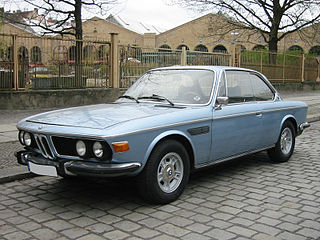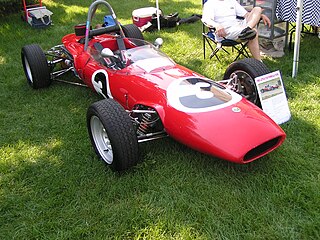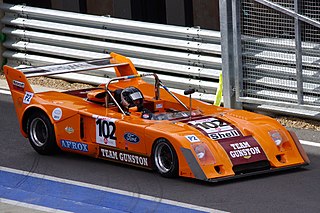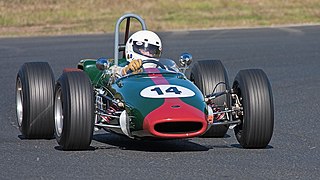
Formula Two is a type of open-wheel formula racing category first codified in 1948. It was replaced in 1985 by Formula 3000, but revived by the FIA from 2009–2012 in the form of the FIA Formula Two Championship. The name returned again in 2017 when the former GP2 Series became known as the FIA Formula 2 Championship.

The BMW M3 is a high-performance version of the BMW 3 Series, developed by BMW's in-house motorsport division, BMW M GmbH. M3 models have been produced for every generation of 3 Series since the E30 M3 was introduced in 1986.

The BMW E9 is a range of coupés produced from 1968 to 1975. Initially released as the 2800 CS model, the E9 was based on the BMW 2000 C / 2000 CS four-cylinder coupés, which were enlarged to fit the BMW M30 six-cylinder engine. The E9 bodywork was built by Karmann.

Chevron Cars Ltd. is an English manufacturer of racing cars, founded by Derek Bennett in 1965. Following Bennett's death in 1978, the firm has remained active in various guises. The original company's designs and name continue to be used to build replacement parts and continuation models of earlier Chevrons. In 2000, Chevron Racing Cars Ltd., founded by Vin Malkie acquired the trade mark Chevron Racing Cars Ltd and in addition to the company's other activities has designed and built new grand tourer racing cars under the Chevron name, as well as other continuation models of earlier Chevrons.

The Chevron B21 is a 2-liter Group 5 sports prototype race car, designed, developed and built by British manufacturer Chevron, in 1972. Over its racing career, spanning 13 years, it won a total of 23 races, scored 45 podium finishes, and clinched 11 pole positions. It was powered by a naturally-aspirated 2.0 L (120 cu in) Ford-Cosworth BDG, or BMW M12/7, four-cylinder engine, both making around 275 hp (205 kW). Only 28 cars were built.

The Chevron B23 is a Group 5 sports prototype race car, designed, developed and built by British manufacturer Chevron, in 1973. Over its racing career, spanning 12 years, it won a total of 12 races, scored 41 podium finishes, and clinched 2 pole positions. It was powered by a naturally-aspirated 3.0 L (180 cu in) Ford-Cosworth DFV Formula One engine, producing 398 hp (297 kW).

The Lotus 51 was an open-wheel Formula Ford race car built in 1967 by the British motorsport team Lotus. It was powered by a 1.6 L (98 cu in) Ford Crossflow four-cylinder engine, developing a respectable 110 hp (82 kW), which drove the rear wheels through either a Renault R-8 type 330 4-speed, or a Hewland 5-speed manual transmission.

The Chevron B26 is a 2-liter Group 6 sports prototype race car, designed, developed and built by British manufacturer Chevron, in 1973. Over its racing career, spanning 14 years, it won a total of 17 race wins, achieved 43 podium finishes, and clinched 9 pole positions. It was powered by a naturally-aspirated 2.0 L (120 cu in) Hart 420R four-cylinder engine, developing 285 hp (213 kW).

The Brabham BT14 was an open-wheel mid-engined formula racing car, designed, developed and built by British manufacturer and constructor Brabham, in 1965. A total of 10 models were produced. It was specifically constructed to compete in Formula Libre racing. It competed in motor racing between 1965 and 1968; winning a total of 10 races, scoring 22 podium finishes, and clinching 4 pole positions. It also contested the 1967 European F2 Championship season, competing in 7 races, but with no success; scoring no wins, pole positions, podium finishes, or scoring any points. It was powered by a naturally-aspirated 1.6 L (98 cu in) Ford twin-cam four-cylinder engine, which droves the rear wheels through a conventional 4-speed manual transmission.
The March 832 was a British open-wheel Formula 2 racing car, built by March Engineering in 1983. The car's best result in Formula 2 racing was third in the 1983 championship season with Beppe Gabbiani scoring 4 wins with Onyx Racing. After finding moderate success in open-wheel racing, it was later decided to convert the car to a closed-wheel sports prototype, for the revived Can-Am series, and compete in 1984. It was powered by the 2-liter BMW M12/7B engine. Kim Campbell successfully won the 2-liter Can-Am Championship that season, not scoring any wins, but managing to score 4 podiums, which was enough to clinch the championship.

The March 732 was a British open-wheel Formula 2 racing car, built by March Engineering and introduced in 1973. It was powered by the 2 L (120 cu in) BMW M12/7 engine. It's Formula Atlantic equivalent, the March 73B, was based on the 732. Frenchman Jean-Pierre Jarier eventually won the 1973 European Formula Two Championship driving a March 732, finishing the season with 8 wins, 9 podium finishes, 4 pole positions, 4 fastest laps, and 78 points.

The Chevron B24 was a Formula 5000 racing car developed by Chevron Cars in 1972.

The Chevron B34 was a successful Formula Atlantic and Formula 3 racing car built by Chevron Cars. It was powered by the Toyota/Novamotor PFT 2T-G 2.0 L (120 cu in) inline-four engine; which was good for 165 hp (123 kW).

The Brabham BT5, and its evolution, the Brabham BT8, are sports racing cars manufactured and developed by Brabham in 1963 (BT5) and 1964 (BT8), respectively. It won a total of 4 races, and achieved 10 podium finishes.

The Chevron B36 was a Group 6 prototype sports car, designed, developed, and built by British manufacturer Chevron Cars Ltd in 1976 and used in sports car racing until 1987. Over that time period, it won a total of 14 races, and achieved 43 podium finishes.

The Chevron B16 was a Group 4 sports prototype race car, designed, developed, and built in 1969 by the British racing car manufacturer Chevron Cars as a two-seater racing sports car for the makes world championship. Brian Redman won the very first outing, the 500 km (310 mi) race at the Nürburgring on September 7, 1969, at a time of 3:13:01.6 hours. The last victory with a Chevron B16 was achieved by Clemens Schickentanz on July 11, 1971, in the sports car race at the Norisring.
The Chevron B6 is a lightweight sports racing car, designed, developed and built by British manufacturer Chevron Cars, in 1967. Only 7 cars were built, which makes it very rare. Over its career, spanning 8 years, it won a total of 15 races, plus 4 additional class wins, clinched 1 pole position, and scored 30 total podium finishes.
The Chevron B3 was the first sports racing car that was developed and built by British manufacturer Chevron, in 1966. It was designed by British engineer, Derek Bennett. It was powered by a naturally-aspirated 1.6 L (98 cu in) Ford twin-cam four-cylinder engine. Over its racing career, spanning two years, it won a respectable 8 races, and took 10 podium finishes.
The Martin BM7, and its successor and derivative, the Martin BM8, are 2-liter sports prototype race cars, designed, developed, and built by British racing driver, automotive engineer, and mechanic, Brian Martin, in 1969 and 1970, respectively. They were constructed to compete in the European 2-Litre Championship sports car racing series. These cars were powered by a number of different engines, including a BMW M12/7, a Ford Motor Company-Cosworth FVC, and a Ford-Cosworth BDX, which all displaced around 2.0 L (120 cu in). These cars won a total of 8 races, and scored 20 podium finishes.

The Lola T210, and its evolution, the Lola T212, are Group 6 sports prototype race cars, designed, developed and built by British manufacturer Lola, for the newly created European 2-Litre sports car racing championship, in 1970.
















